Essay by Eleanor Jackson
The Christian Bible emphasises the importance of prayer as a way to become closer to God and to ask for divine aid. From around 1200 in Western Europe, there was an unprecedented rise in laypeople’s prayer-books, leading to the emergence of what would become the most popular book of the late Middle Ages: the Book of Hours. These books allowed people to develop more complicated routines of personal devotion, and to fill their days with prayer as never before. From a modern perspective, they give us a fascinating insight into people’s daily lives, self-perceptions and heartfelt beliefs.
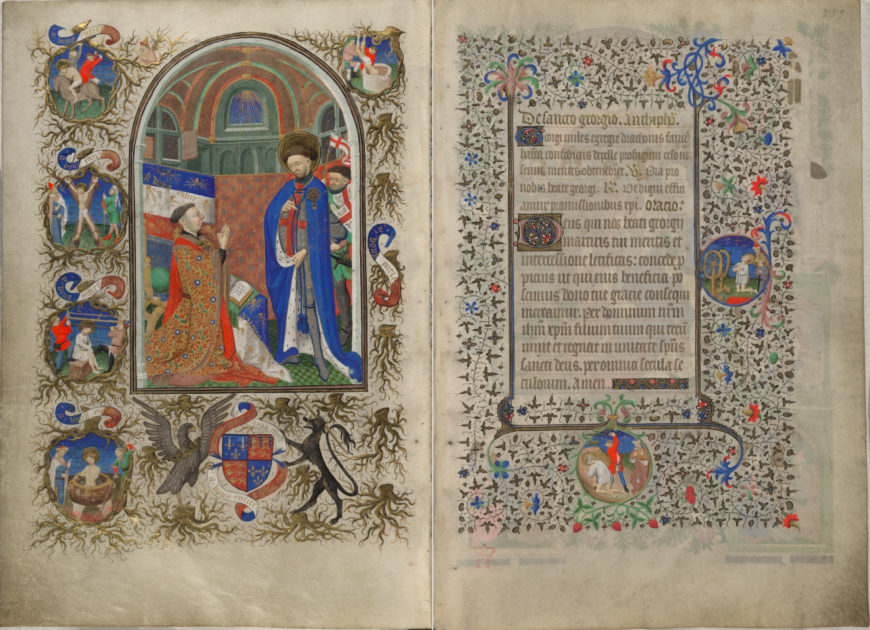
John, Duke of Bedford, praying to St George (detail), The Bedford Hours, c. 1410–30, ink on parchment, 26 x 18.5 cm (The British Library)
Medieval prayer-books could contain a wide variety of texts, often written in Latin, the language of the Church. The prayers were frequently based on the liturgy of church services, or on the devotional practices of monks and nuns. Many prayer-books also included images, both to appeal to the eye and to deepen the spiritual experience of prayer. Sometimes the original owners had their portraits painted inside, kneeling in prayer just as they would when the manuscript was in use. For example, in this image from the Bedford Hours, John, Duke of Bedford, is depicted praying with his book whilst St George, his patron saint, stands before him listening. The image illustrates how people envisioned a prayer-book working, as an aid to help its owner to communicate with heavenly persons.
What does the Book of Hours contain?
Books of Hours are so-named because they contain sequences of prayers known as offices, arranged in sections for reading throughout the day at set hours. These were the canonical hours of Matins (after midnight), Lauds (before dawn), Prime (at daybreak), Terce (mid-morning), Sext (midday), None (afternoon), Vespers (sunset) and Compline (before bed). By adopting this format of prayer, laypeople imitated the practices of monks and nuns who prayed together at the canonical hours as part of the daily services known as the Divine Office. But the prayers in the Book of Hours were shorter to fit around people’s everyday lives, and did not change with the day or liturgical season like the complex offices recited by the clergy. It was a format that proved hugely popular.
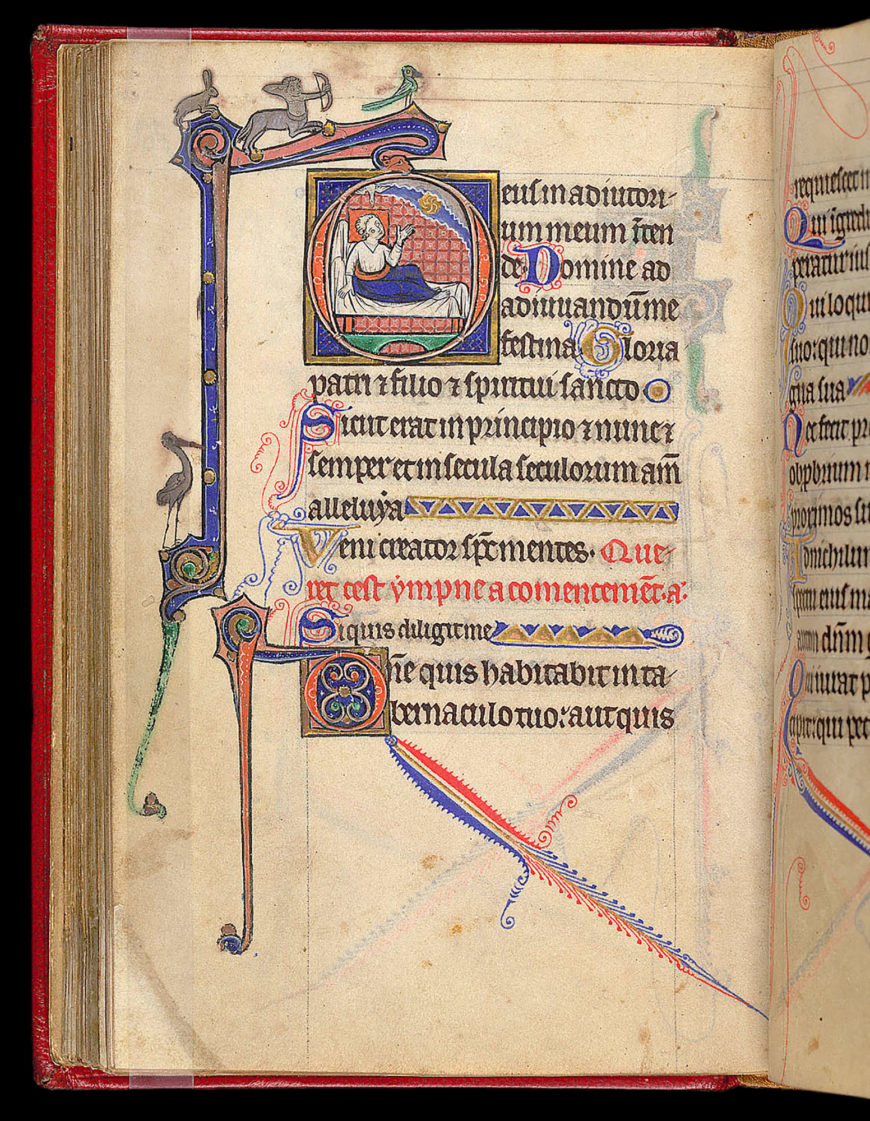
Book of Hours, late 13th century, England (possibly Oxford or the West Midlands), ink on parchment, 16 x 10.5 cm (The British Library)
This 13th-century Book of Hours is unusual for beginning each section with a picture of a typical activity for that hour of the day. For example, at the opening of the text for Prime (daybreak) we see a figure rising from bed with the sun shining overhead. The picture scheme illustrates how praying the hours structured a person’s day and blended with the routine of their lives.
Praising the Virgin Mary
While Books of Hours usually included several offices focussing on different themes, the core text of any Book of Hours was the office known as the Hours of the Virgin. Each hour is provided with psalms, hymns, Bible readings and devotional phrases reflecting on the life of the Virgin Mary and praising her goodness. Its dominant position in the Book of Hours reveals the intense popularity of the Virgin in the late Middle Ages.
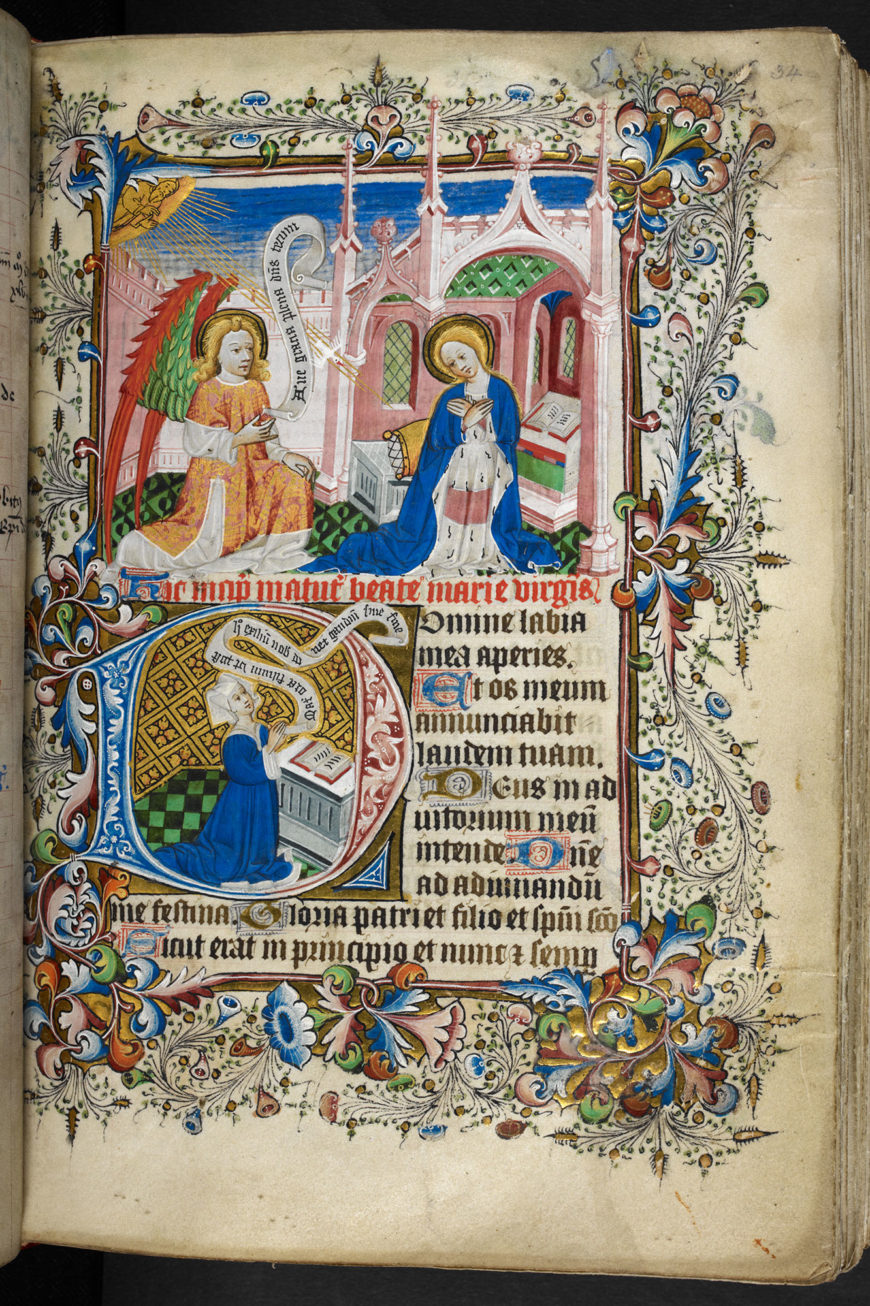
The beginning of the Hours of the Virgin (detail), The Beaufort/Beauchamp Book of Hours, c. 1411–15 and c. 1425–43, Netherlands, ink on parchment, 21.5 x 15 cm (The British Library)
The Hours of the Virgin are often illustrated with scenes from Mary’s life, emphasising both the relatable and extraordinary aspects of her story. The subject traditionally associated with the first hour of Matins (after midnight) is the Annunciation, when the Angel Gabriel revealed to Mary that she was going to become the Mother of Christ. In this typical example from the Beaufort/Beauchamp Hours, we can see that before Gabriel appeared, Mary was reading alone in her chamber. The image of personal reading connects Mary and the book’s owner, who is also pictured reading alone in her chamber in the decorated initial below. The woman, probably Margaret Beauchamp (1405/06–1482), Duchess of Somerset, has a book identical to the Virgin Mary’s and wears a blue dress echoing the colour of the Virgin Mary’s cloak. The written scroll that flutters from her hands is the medieval equivalent of a speech bubble, showing us words of prayer that she offers up to the Virgin Mary: ‘Mother, pray to your son that after this our exile he may grant us joy without end’.
Devotion to the Passion
Another popular way to illustrate the Hours was with episodes from Christ’s Passion, the period of suffering leading up to his death. The subject was commemorated by offices such as the Hours of the Cross and the Hours of the Passion. It also gave rise to a distinctive form of prayer that involved listing or picturing the individual incidents of Christ’s suffering, often through meditation on devotional images. These images often focussed on the Instruments of the Passion, a series of objects that were associated with key moments in Christ’s suffering such as the Cross on which he was crucified, the lance with which he was pierced, the sponge on which he was offered gall and vinegar, the column on which he was whipped and the cloth on which he wiped his face.
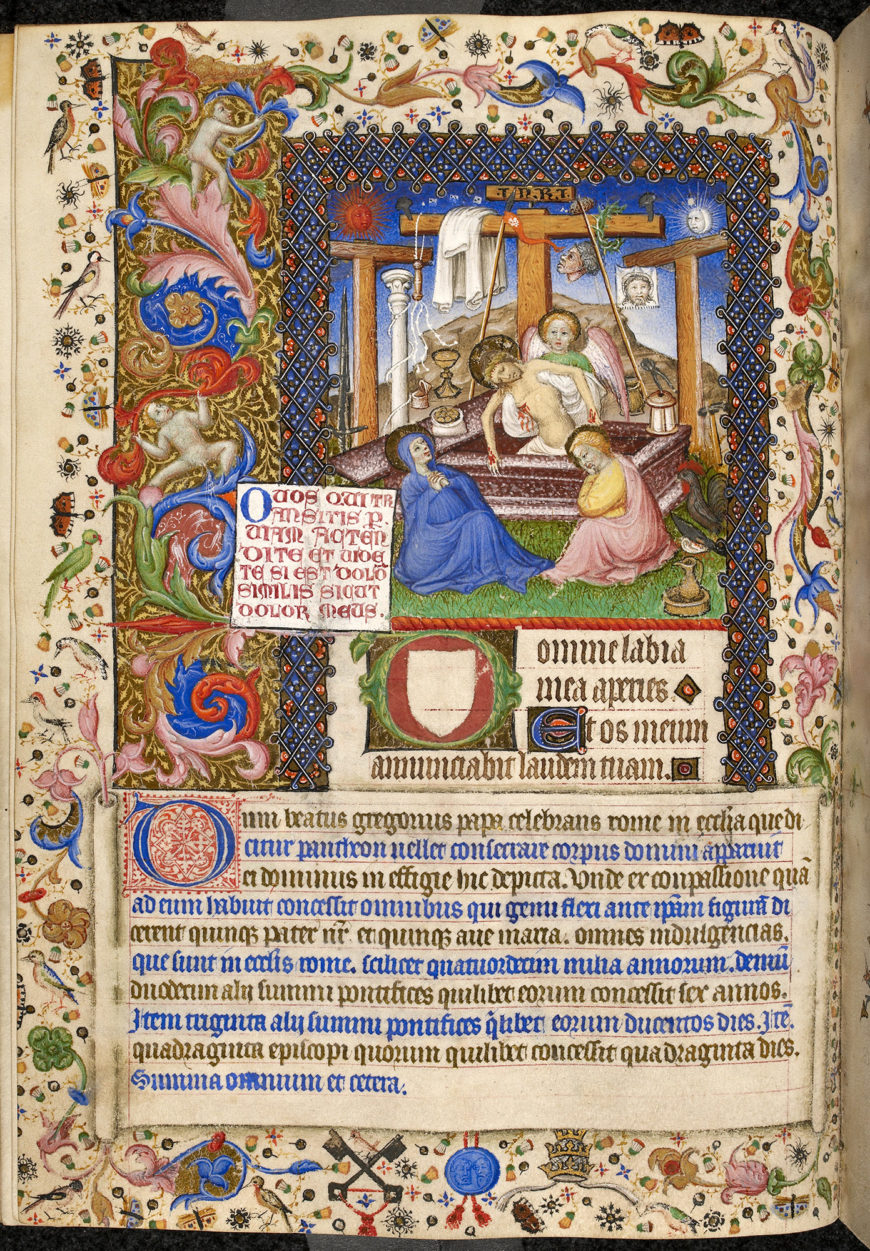
An illuminated indulgence depicting Christ surrounded by the instruments of the Passion (detail), Book of Hours, 1400–1410, France, ink on parchment, 22.5 x 16 cm (The British Library)
This text from a French Book of Hours gives detailed instructions about how to pray before an image of the Man of Sorrows – that is, an image of the dead body of Christ, displaying his wounds, surrounded by the Instruments of the Passion. The text is an indulgence, a type of pardon often found in late medieval prayer-books that promises spiritual privileges in return for performing pious acts. It explains that when Pope Gregory the Great (c. 540–604) was celebrating Mass in the Pantheon, the body of the Lord appeared to him just as it is depicted here. Out of compassion, Pope Gregory agreed to give everyone who said five Pater nosters and five Ave Marias while kneeling before the image 14,000 years of indulgences. The Pater noster (‘Our Father’) and Ave Maria (‘Hail Mary’) are short prayers that every Christian was expected to know by heart. The text’s insistence that the prayers must be recited before the image illustrates the function of sacred images as tools to deepen the spiritual connection established through prayer.
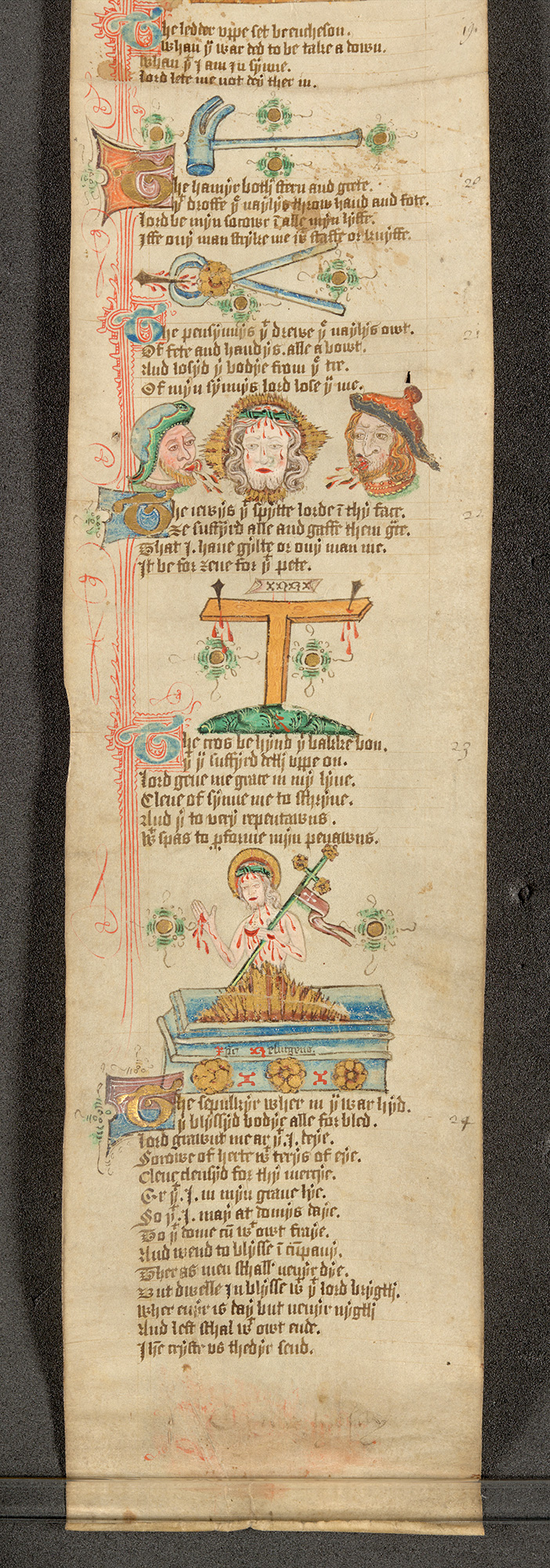
Middle English prayer-poem ‘O Vernicle’ (Oh Holy Face) (detail), An English Arma Christi Roll, second quarter of the 15th century, ink on vellum, 134.5 x 9 cm (The British Library)
The Instruments of Christ’s suffering and death formed the basis of vernacular prayers that circulated in a variety of different formats, such as this prayer scroll featuring the illustrated Middle English prayer-poem O Vernicle (‘Oh Holy Face’). The poem prompts meditation on each of the Instruments of the Passion, combining the acts of reading the text, looking at the images and unfurling the roll to fully engage the reader in the devotional experience. This aims to move the reader to an empathetic understanding of the Passion, as in this stanza about the pincers:
The pincers that drew the nails out,
Of feet and hands, all about,
And loosed the body from the tree,
Of my sins, Lord, loose thou me.
Calling on the saints
Saints are people who lived such exceptionally holy lives that they are recognised by the Church as having attained an exalted position in Heaven. Medieval Christians venerated saints and asked for their help as patrons and protectors. Whilst the most intense devotions were generally reserved for Christ and the Virgin Mary, medieval prayer-books also reveal this deep personal connection that people felt with saints. Books of Hours begin with a calendar for keeping track of saints’ feast days throughout the year. They also include a litany (a list of saints who are each asked to ‘pray for us’) which was recited daily.
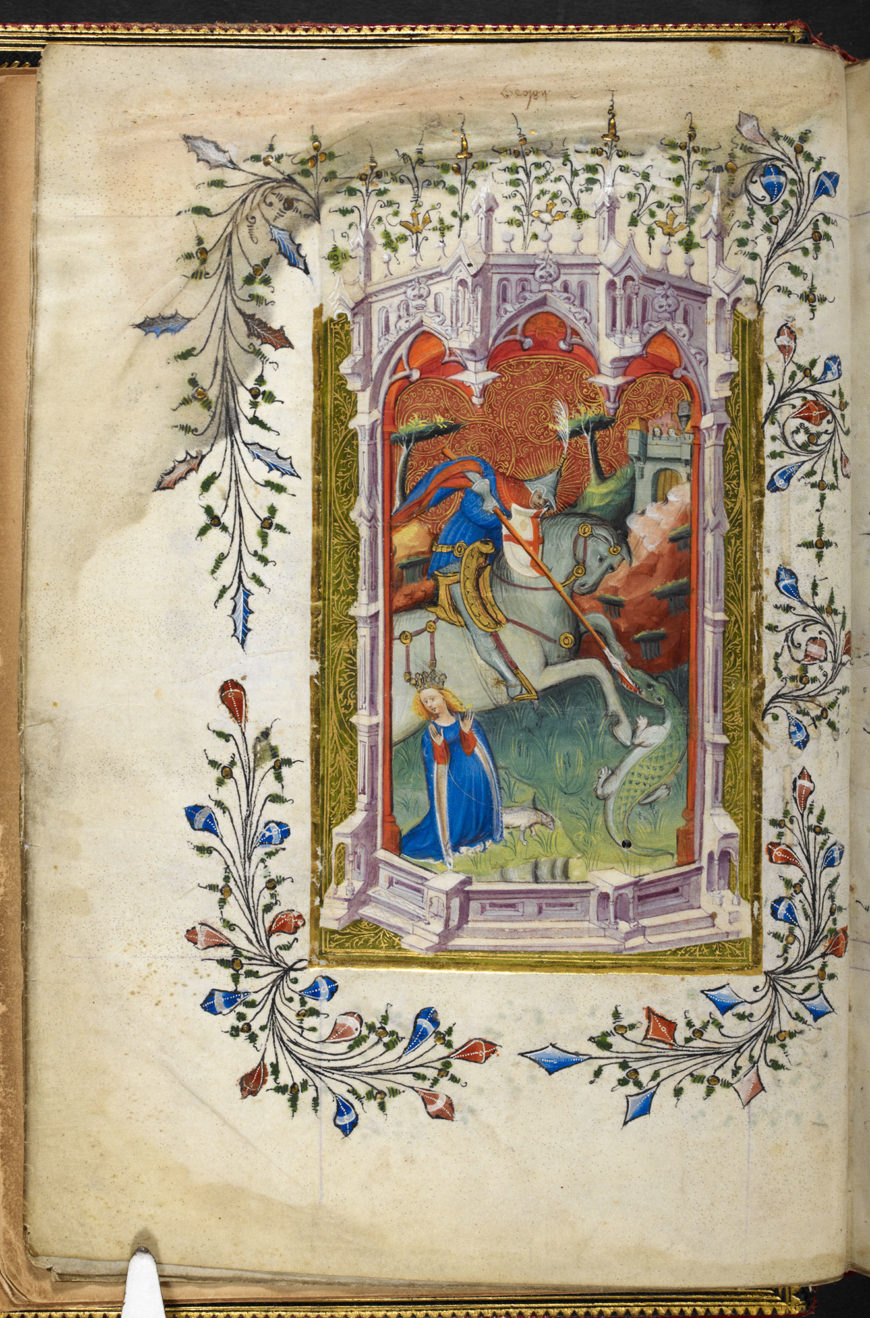
Suffrage to St. George, the dragon slayer (detail), The Beaufort/Beauchamp Book of Hours, c. 1411–15 and c. 1425–43, Netherlands, ink on parchment, 21.5 x 15 cm (The British Library)
Books of Hours generally also contain prayers to individual saints known as suffrages. A typical suffrage consists of a summary of the life and special significance of the saint, a request for the saint’s prayers and a petition to God. When seeking help with a problem, people called on the saint whose experiences were thought to give them particular influence in that area. For example, this suffrage to St George from the Beaufort/Beauchamp Hours, illustrated with a dramatic scene of the saint fighting the dragon, appeals to his skills in vanquishing evil: ‘pray for us, St George, that our visible and invisible enemies are extremely weak’.
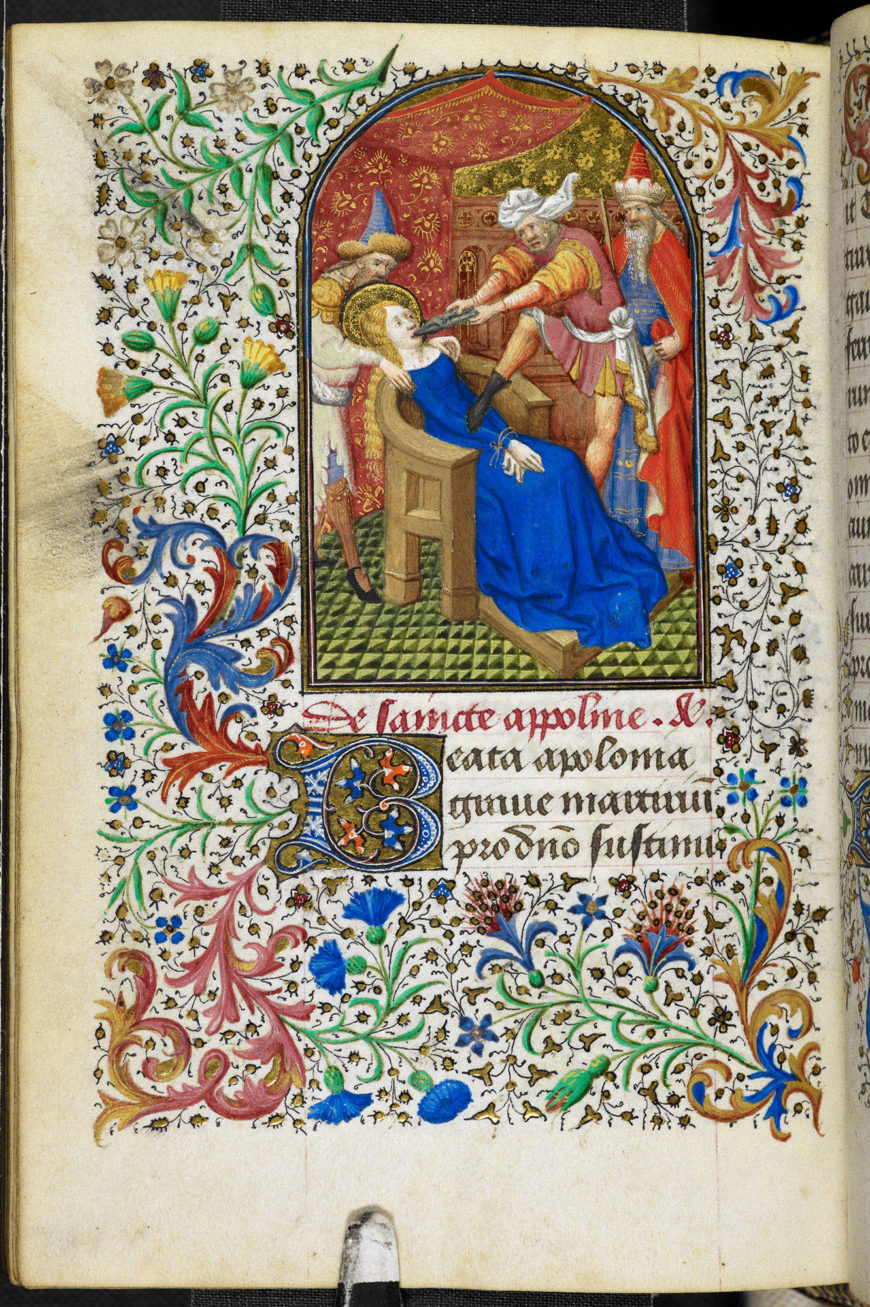
Suffrage to St Apollonia (detail), The Dunois Hours, c. 1439–50, Paris, ink on parchment, 13.5 x 9.5 cm (The British Library)
The selection of suffrages in a Book of Hours was often carefully tailored to its owner’s interests and even medical needs. St Apollonia, who had been tortured for her faith by having her teeth pulled out, was credited with special powers against toothache. This suffrage to St Apollonia from the Dunois Hours explains that while her teeth were extracted, ‘she prayed in that torment to Lord Jesus Christ that whoever should bear her name upon himself would not feel pain in his teeth’.
Prayers for the dead
Many of the prayers in medieval prayer-books are either directly or implicitly concerned with the fate of the soul after death. This concern is most directly expressed in the Office of the Dead, an essential element of Books of Hours, which was the same text that was used in church in the lead-up to funerals. People regularly prayed the Office of the Dead for the souls of their departed loved ones, asking God to forgive the sins of the deceased and to bless them with a place in Heaven.
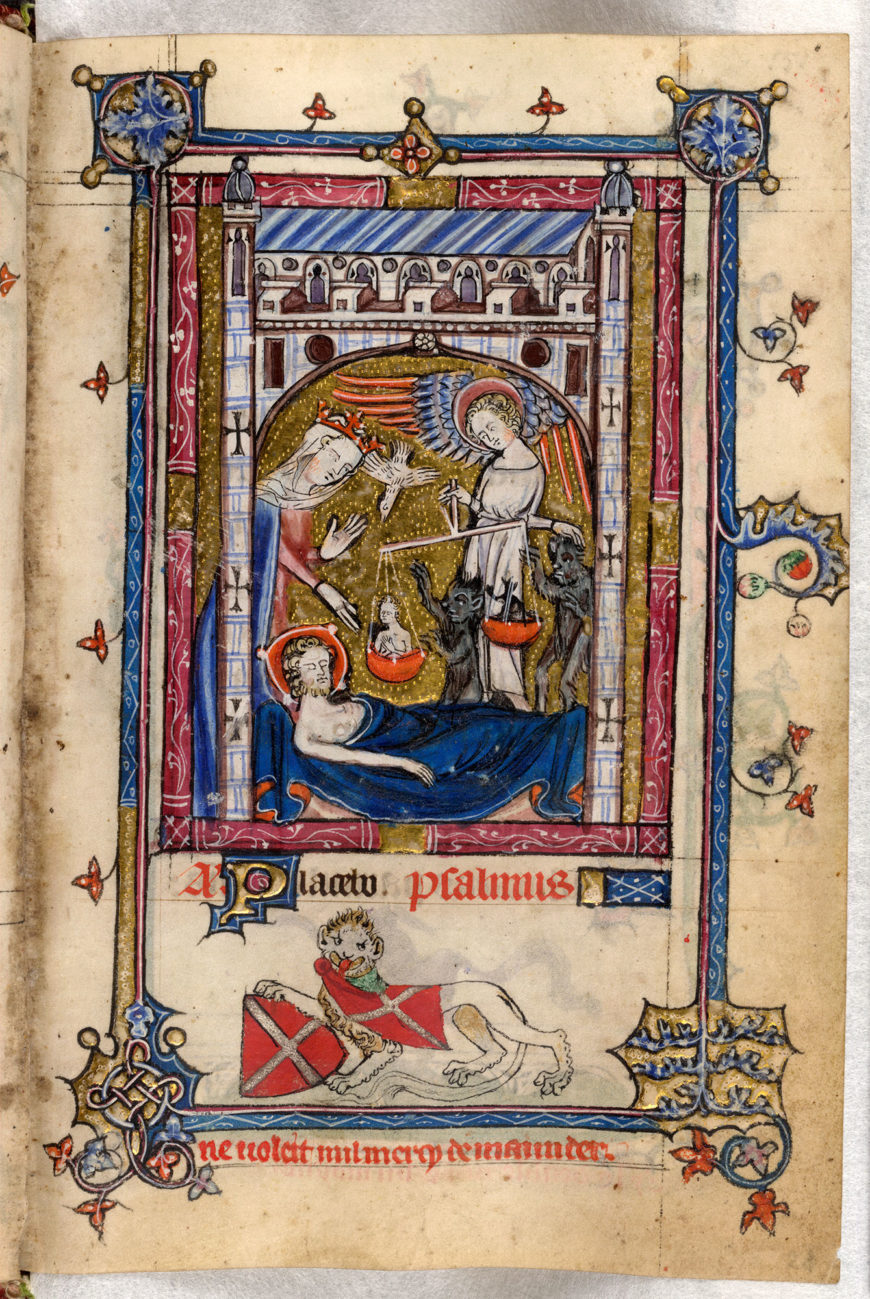
The beginning of the Office of the Dead, The Taymouth Hours, second quarter of the 14th century, ink on parchment (The British Library)
While the opening of the Office of the Dead is most often illustrated with a picture of a funeral service, in the Taymouth Hours it opens with a scene representing the spiritual struggle that was thought to happen after death. A man is shown lying on his deathbed, his soul having just departed his body. The Archangel St Michael judges the soul by measuring it against the weight of a small demon on a set of weighing scales. Two more demons are eagerly trying to unbalance the scales, while the Virgin Mary aids the soul with her blessings. The image might remind the reader of the crucial importance of prayer, by which they too could influence the outcome of the soul’s judgement.
Rosary prayers
During the 15th century, a form of devotion became popular that was often used alongside the Book of Hours. This was the rosary – a sequence of prayers, especially the Ave Maria and Pater Noster, recited from memory in a sequence indicated by beads on a string.
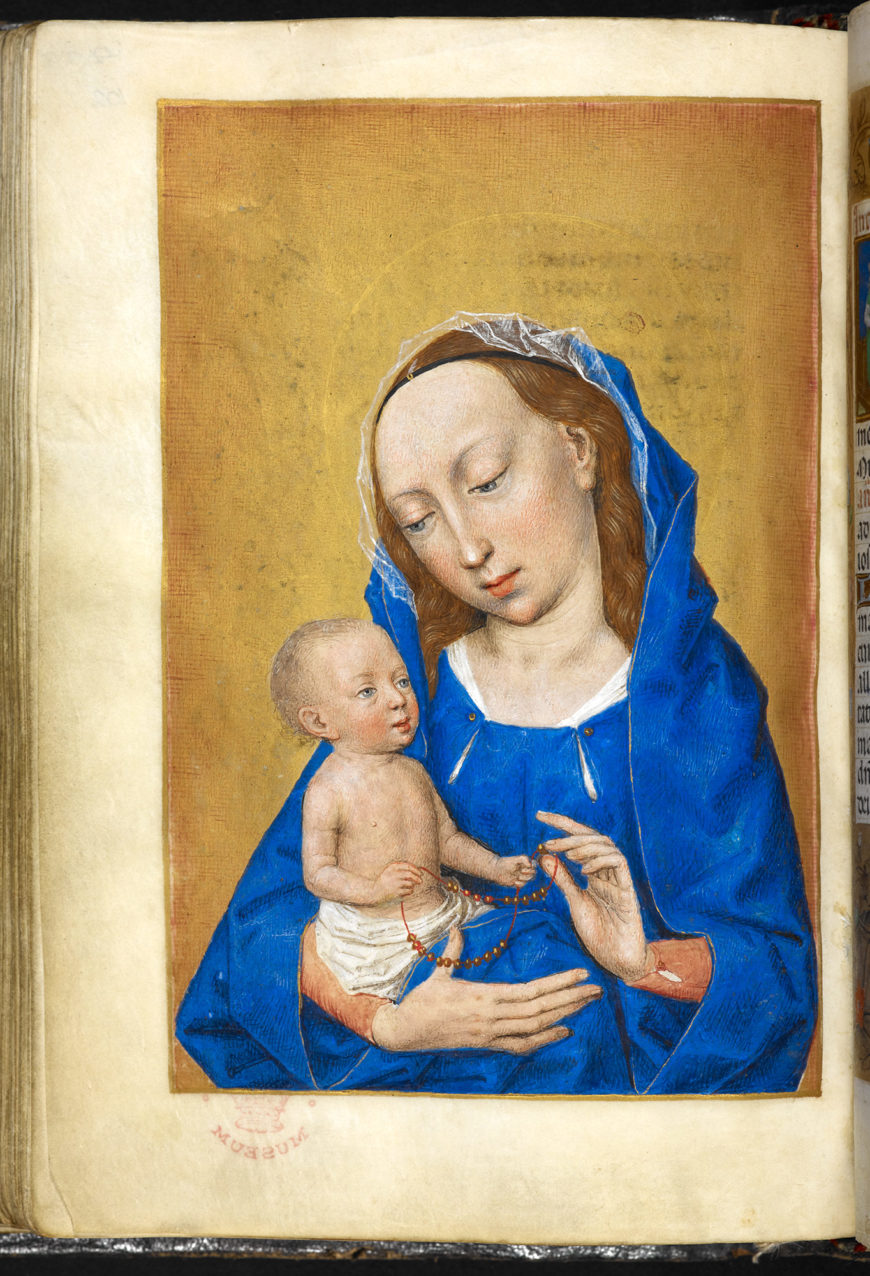
Opening of the Office of the Blessed Virgin, The Huth Hours, 1485–90, ink on parchment, 15 x 10.5 cm (The British Library)
This short Office of the Virgin Mary in the Huth Hours is prefaced with a picture of the Virgin and Child playing with a string of rosary beads, just like those that the owner probably passed through their fingers while reading the book. Used on its own, the rosary provided a much simpler way of praying than Books of Hours and other medieval prayer-books. By the end of the 16th century it had taken their place as the most popular tool of personal devotion.
Originally published by The British Library.

